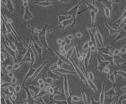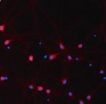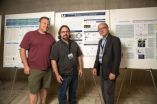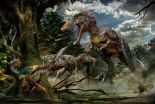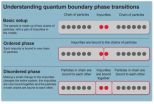(Press-News.org) Emotions like fear, anger, sadness, and joy enable people to adjust to their environment and react flexibly to stress and strain and are vital for cognitive processes, physiological reactions, and social behaviour. The processing of emotions is closely linked to structures in the brain, i.e. to what is known as the limbic system. Within this system the amygdala plays a central role – above all it processes negative emotions like anxiety and fear. If the activity of the amygdala becomes unbalanced, depression and anxiety disorders may develop.
Researchers at the Psychiatric University Hospital of Zurich have now shown that psilocybin, the bioactive component in the Mexican magic mushroom, influences the amygdala, thereby weakening the processing of negative stimuli. These findings could "point the way to novel approaches to treatment" comments the lead author Rainer Krähenmann on the results which have now been published in the renowned medical journal "Biological Psychiatry".
Psilocybin inhibits the processing of negative emotions in the amygdala
The processing of emotions can be impaired by various causes and elicit mental disorders. Elevated activity of the amygdala in response to stimuli leads to the neurons strengthening negative signals and weakening the processing of positive ones. This mechanism plays an important role in the development of depression and anxiety disorders. Psilocybin intervenes specifically in this mechanism as shown by Dr. Rainer Krähenmann's research team of the Neuropsychopharmacology and Brain Imaging Unit led by Prof. Dr. Franz Vollenweider.
Psilocybin positively influences mood in healthy individuals. In the brain, this substance stimulates specific docking sites for the messenger serotonin. The scientists therefore assumed that psilocybin exerts its mood-brightening effect via a change in the serotonin system in the limbic brain regions. This could, in fact, be demonstrated using functional magnetic resonance imaging (fMRI). "Even a moderate dose of psilocybin weakens the processing of negative stimuli by modifying amygdala activity in the limbic system as well as in other associated brain regions", continues Krähenmann. The study clearly shows that the modulation of amygdalaactivity is directly linked to the experience of heightened mood.
Next study with depressive patients
According to Krähenmann, this observation is of major clinical importance. Depressive patients in particular react more to negative stimuli and their thoughts often revolve around negative contents. Hence, the neuropharmacologists now wish to elucidate in further studies whether psilocybin normalises the exaggerated processing of negative stimuli as seen in neuroimaging studies of depressedpatients - and may consequently lead to improved mood in these patients. .
Rainer Krähenmann considers research into novel approaches to treatment very important, because current available drugs for the treatment of depression and anxiety disorders are not effective in all patients and are often associated with unwanted side effects.
INFORMATION:
Further reading:
Rainer Kraehenmann, Katrin H. Preller, Milan Scheidegger, Thomas Pokorny, Oliver G. Bosch, Erich Seifritz, Franz X. Vollenweider,(in press). Psilocybin-Induced Decrease in Amygdala Reactivity Correlates with Enhanced Positive Mood in Healthy Volunteers. Biological Psychiatry. http://dx.doi.org/10.1016/j.biopsych.2014.04.010
Contacts:
Prof. Dr. Franz Vollenweider
Psychiatric University Hospital of Zurich
University of Zurich
Tel.: +41 44 384 24 04
Email: vollen@bli.uzh.ch
Dr. Katrin Preller
Psychiatric University Hospital of Zurich (PUKZH)
University of Zurich
Tel.: +41 44 384 26 25
Email: preller@bli.uzh.ch
Nathalie Huber
Media Relations
University of Zurich
Tel. +41 44 634 44 64
Email: nathalie.huber@kommunikation.uzh.ch
Psilocybin inhibits the processing of negative emotions in the brain
2014-05-07
ELSE PRESS RELEASES FROM THIS DATE:
rAAV/ABAD-DP-6His attenuates oxidative stress induced injury of PC12 cells
2014-05-07
The effects of Amyloid beta (Aβ)-Aβ-binding alcohol dehydrogenase (ABAD) may exacerbate Alzheimer's disease pathology. Therefore, blocking Aβ-ABAD-mediate effects with ABAD decoy peptide (ABAD-DP) may be a potential therapeutic strategy for Alzheimer's disease. Dr. Jiang Wu and team from the First Hospital of Jilin University in China successfully constructed a recombinant adenovirus constitutively secreting and expressing Aβ-ABAD decoy peptide (rAAV/ABAD-DP-6His). Their results showed that rAAV/ABAD-DP-6His increased superoxide dismutase activity in ...
Starting signal for antiviral defense
2014-05-07
In human cells, DNA occurs only in the cell nucleus as the carrier of genetic information. In order to protect it, specialized proteins regularly scan the individual strands for defects, and repair them. One example of this is the protein Rad50, a DNA sensor that binds to DNA and detects defective sites. A team of scientists headed by Prof. Jürgen Ruland of the TUM together with colleagues from the LMU have now discovered another important task performed by Rad50.
There is normally no DNA in the cytoplasm surrounding the cell nucleus. However, if any does turn up there, ...
Geniposide protects hippocampal neurons via the non-classical estrogen signaling pathway
2014-05-07
Amyloid-β (Aβ) plaques and neurofibrillary tangles are the main pathological hallmarks of Alzheimer's disease, as well as the loss of neurons and synapses. recent reports have shown that estrogen exerts neuroprotective effects. However, large clinical trials in postmenopausal women indicated adverse side-effects of estrogens, such as increased incidence of breast cancer and metrocarcinoma, thereby preventing clinical use of estrogen. Tongluojiunao (TLJN) is an herbal medicine consisting of two main components, geniposide and ginsenoside Rg1. Prof. Qian Hua and ...
Discovery offers new possibilities for clean energy research
2014-05-07
University of Houston physicists have discovered a new thermoelectric material offering high performance at temperatures ranging from room temperature up to 300 degrees Celsius, or about 573 degrees Fahrenheit.
"This new material is better than the traditional material, Bismuth telluride, and can be used for waste heat conversion into electricity much more efficiently," said Zhifeng Ren, M.D. Anderson Chair professor of physics at UH and the lead author of a paper describing the discovery, published online by Nano Energy.
Ren, who is also principal investigator at the ...
Ability to isolate and grow breast tissue stem cells could speed cancer research
2014-05-07
LA JOLLA—By carefully controlling the levels of two proteins, researchers at the Salk Institute have discovered how to keep mammary stem cells—those that can form breast tissue—alive and functioning in the lab. The new ability to propagate mammary stem cells is allowing them to study both breast development and the formation of breast cancers.
"What we've shown is that we can take these cells out of a mouse and study them and regulate them in the laboratory by providing them with a specific factor," says Peter C. Gray, a staff scientist in Salk's Clayton Foundation ...
Today's offenders are tomorrow's victims in gangs
2014-05-07
HUNTSVILLE, TX (5/7/14) -- Gang members are twice as likely to become both a victim and an offender of a crime than non-gang members, as single acts of violence often lead to retribution between gangs as a whole, according to a new study.
"In other words, gang members are not distinctly offenders or victims; instead, gang membership is a common source of both forms of violence," said David Pyrooz, an assistant professor at Sam Houston State University, College of Criminal Justice and principal author of the study. "Today's criminal offender is tomorrow's victim, and today's ...
Arctic study sheds light on tree-ring divergence problem
2014-05-07
SAN FRANCISCO -- Changes in tree-ring density in the Arctic may be evidence of changes in light intensity during the trees' growth, according to a new study by San Francisco State University researcher Alexander Stine.
The finding has direct implications for the tree-ring "divergence problem," a phenomenon that has received considerable media attention but has been widely misinterpreted, said Stine, an assistant professor of Earth & climate sciences.
Tree rings consist of a low density ring, which forms early in the growing season, and a high density ring that forms ...
Newly found dinosaur is long-nosed cousin of Tyrannosaurus rex
2014-05-07
Scientists have discovered a new species of long-snouted tyrannosaur, nicknamed Pinocchio rex, which stalked the Earth more than 66 million years ago.
Researchers say the animal, which belonged to the same dinosaur family as Tyrannosaurus rex, was a fearsome carnivore that lived in Asia during the late Cretaceous period.
The newly found ancient predator looked very different from most other tyrannosaurs. It had an elongated skull and long, narrow teeth compared with the deeper, more powerful jaws and thick teeth of a conventional T. rex.
Palaeontologists were uncertain ...
Melting an entire iceberg with a hot poker: Spotting phase changes triggered by impurities
2014-05-07
"What a curious feeling," says Alice in Lewis Carroll's tale, as she shrinks to a fraction of her size, and everything around her suddenly looks totally unfamiliar. Scientists too have to get used to these curious feelings when they examine matter on tiny scales and at low temperatures: all the behaviour we are used to seeing around us is turned on its head.
In research published today in the journal Nature Communications, UCL scientists have made a startling discovery about a familiar physical effect in this unfamiliar setting.
Phase transitions are a category of ...
Sprites form at plasma irregularities in the lower ionosphere
2014-05-07
Atmospheric sprites have been known for nearly a century, but their origins were a mystery. Now, a team of researchers has evidence that sprites form at plasma irregularities and may be useful in remote sensing of the lower ionosphere.
"We are trying to understand the origins of this phenomenon," said Victor Pasko, professor of electrical engineering, Penn State. "We would like to know how sprites are initiated and how they develop."
Sprites are an optical phenomenon that occur above thunderstorms in the D region of the ionosphere, the area of the atmosphere just above ...
